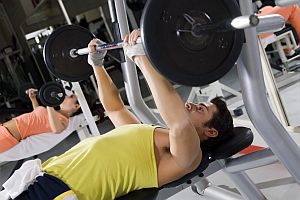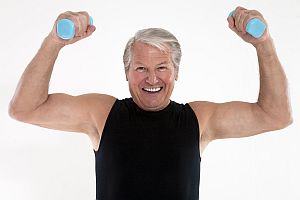Want Stronger Bones? Weight Training Can Help!

As we age, we normally lose a certain amount of bone density. This is a particular problem for postmenopausal women due to the loss of estrogen, which protects against bone loss. Although men are less likely to suffer from osteoporosis (because their bones are generally larger and more dense), they can also be subject to bone loss if they do not get a sufficient amount of exercise. So what can be done to avoid it? Along with a healthy diet, studies have shown that weight-bearing exercise can help to maintain bone density as we age.
Professor of exercise science at California Lutheran University, Dr. Steven Hawkins, says “Exercise stimulates bone formation, because bone put under moderate stress responds by building density, and, depending on your age and workout regimen, it can either increase or maintain bone-mass density.”
Weight training (also referred to as strength training) increases bone mass, particularly that of the spine. A study performed by researchers at McMaster University in Ontario, Canada, showed that postmenopausal women who do not participate in strength training lose bone mass. However, those women who participated in a year-long strength training program increased their spinal bone mass by nine percent.
Strength training does not mean you have to go to the gym every day and train to Olympian standards. It only requires regularly performing a variety of simple, weight-bearing exercises. Much as a muscle becomes larger and stronger the more you use it, bones become stronger and denser the more stress that is placed upon them.
Gary Null, in his book Power Aging notes “Weight lifting, including curls and bench presses, is a beneficial activity.” And for those who’d rather not spend any time around a gym, “Dancing, stair-climbing and brisk walking are all weight-bearing exercises, which promote (good) mechanical stress in the skeletal system, contributing to the placement of calcium in bones.” But what about aerobic exercises? While they are very good for your cardiovascular system, Aerobic exercises such as biking, rowing and swimming do not strengthen the bones” as they do not place enough stress on the skeletal system to stimulate bone growth.
You only need about 15-30 minutes of weight training two or three times a week to help maintain your bone density. You can use weight machines at the gym, or consider attaching some light weights to your arms and legs as you do a regular workout to increase the stress on your skeletal system. Even gardening can be a good way to help preserve bone mass, as it involves such bone-strengthening activities as pulling weeds, pushing a lawnmower or wheelbarrow, turning over soil, etc. Even something as simple as carrying groceries to and from the car can help.
So consider adding a little weight training to your daily routine so you can maintain your bone health and (with a bit of luck) remain fracture-free far into your later years.
If you need more ideas on how to improve your bone health, be sure to schedule an appointment with Dr. Oblander by calling our office at 406-652-3553!
